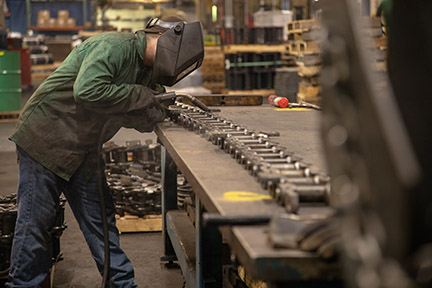Switch to Metal-Cored Wire Improves Efficiency, Quality for Chain Manufacturer
As part of its continued drive for improvement and innovation, Webster Industries recently converted from solid wire to metal-cored wire in its robotic, fixed automation and semi-automatic welding operations. The change allowed the company to boost efficiency, reduce costs and improve customer lead times.
Controlling the production process from start to finish allows Webster Industries to maintain its reputation for high-quality products and service. Two of the biggest customer markets for Webster are forest products and grain handling, but the company also serves customers in recycling, cement mills, construction, asphalt, food processing and steel manufacturing.
“We really have diverse product offerings, which requires a lot of technical skills,” says President and CEO Andrew Felter. “We’re a made-to-order shop. That’s been our niche.”
Over the years, Webster Industries has become a flexible operation with a strong concentration on customer service and meeting customer needs quickly with low lead times. To achieve this, the company is vertically integrated and has capabilities to do many different things — from fabrication and welding to machining and foundry work.
“You’re not in business for 140 years because you don’t know what you’re doing,” Felter says. “We have a whole host of different manufacturing processes that we continue to advance and improve on over time. We are definitely committed to quality and innovation.”
A switch to metal-cored wire
Webster Industries traditionally used solid wire in its welding operations. A welding distributor was brought in to do some testing and help find potential process improvements.
“Some of the challenges we faced in our welding department with solid wire were quality, weld penetration and just overall cleanliness of the welds,” says Tony Secoy, production supervisor.
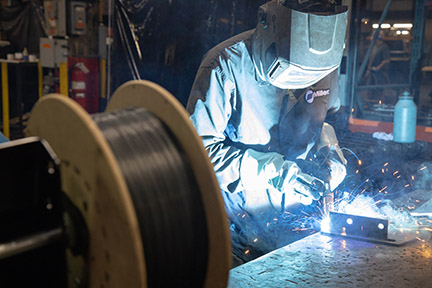
86R metal-cored wire in its robotic, fixed automation and semi-
automatic welding operations, a change that allowed Webster to
boost efficiency, reduce costs and improve customer lead times.
The welding distributor brought in representatives from Hobart and Miller Electric Mfg. LLC. After studying the company’s production and baselines, they suggested Webster consider a change to metal-cored wire. Sample testing by Hobart comparing the original solid wire to welds completed with Hobart® FabCOR® 86Rmetal-cored wire revealed the potential benefits for weld quality and productivity.
“I think the biggest thing for us is how they worked with us and became a part of our staff here, to help us get through some issues we were having in our welding departments,” says Mark Kuenzli, Webster operations manager.
The company made the switch and started using the metal-cored wire in its welded steel drag chain manufacturing processes. The chains are designed for drag conveyors in rugged and demanding environments. A unique two-piece welded barrel offers better scraping action as well as double thickness at the wear points. And the rugged welded construction permits high speeds, minimal lubrication and easy modification for application-specific attachments.Webster is also using the metal-cored wire in its sheet metal fabrication department on vibratory conveyors and other component parts, as well as on the sprocket line.
“Now we have one wire to meet our needs across applications — one type of wire and one size of wire,” Kuenzli says. “It really helped reduce our inventory and what we’ve had to carry in stock.”
Significant efficiency improvements
With the switch to FabCOR 86R wire, Webster Industries saw efficiency increase by 18% to 20% in its welding operations. These productivity gains were due to many factors: faster deposition rates and travel speeds, reduced rework and less time spent on post-weld cleaning due to less spatter generated.
All of these efficiency improvements, coupled with the decrease in time and money spent on rework and scrapped parts, helped Webster reduce overall costs. Metal-cored wire also delivers better penetration compared to solid wire, eliminating the issues the company was having with poor penetration.
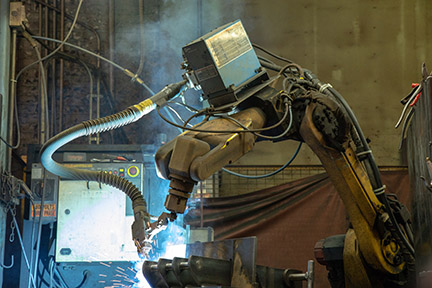
With the switch to metal-cored wire, Webster Industries
saw efficiency increase by 18% to 20% in its welding
operations.
“We definitely have seen an improvement in our quality and the number of good parts coming off the welding lines as opposed to nonconforming parts,” Kuenzli says. “It tests much better when we do our quality testing.”
The company’s welders like that the metal-cored wire burns more cleanly and can easily burn through oil, mill scale or dirt on the base material. This helps reduce the amount of time they have to spend cleaning the material before welding and cleaning off spatter after the weld.
“I’m not spending 15 minutes for every part cleaning the spatter off before we send it on to the next operation,” says welder Tyler Crapo.
The higher deposition rate and lower wire speed means the welders can use less wire for the same wire size and are able to weld faster.
“I have noticed a lot of productivity improvements, whether it’s using less wire so my drum lasts longer or that we can run faster because it burns hotter and gets better penetration for less welding,” Crapo says.
While the metal-cored wire does have a higher upfront cost compared to solid wire, it provided a fast payback for Webster Industries thanks to the efficiency improvements and reduced scrap.
“Even though the FabCOR 86R wire has a slightly higher cost than our previous product, we found that with the increased efficiency, increased throughput and higher-quality parts that we’re putting into our chains, the actual cost to use the metal-cored wire is less than what we were paying before,” Kuenzli says.
Benefits for welder training
The FabCOR 86R wire also has a wider operating window and is more forgiving to adjustments and variations in technique by welding operators. This not only helps experienced welders make quality welds more easily — it also helps Webster Industries train new welders.
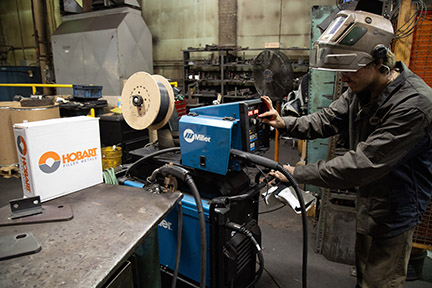
welding operators to easily switch between regular MIG and
pulsed MIG welding.
“That’s where we’ve really had good luck with the FabCOR 86R, where maybe a more inexperienced welder can step in and not have as many issues as they learn how to put the type of welds that we need,” Kuenzli says.
A versatile welder for MIG and pulsed MIG
In addition to converting from solid wire to metal-cored wire, Webster Industries also invested in a new welding system that has delivered more ease of use and versatility in welding processes.
The Deltaweld® 350 MIG welder with Intellx™ Pro feeder from Miller allows Webster’s welding operators to easily switch between regular MIG and pulsed MIG welding. The company uses the machine for fill-in welds and semi-automatic welding to tack parts and weld complex parts by hand.
The system’s pulsed MIG welding capabilities deliver cleaner welds, greater deposition rates and faster travel speeds compared to conventional MIG. The system also allows operators to preprogram gas, wire and speed settings for different applications, so they can easily pull up those settings when they switch between jobs.
“It just gives you so many options, being able to run different weld schedules during the same job,” Crapo says. “It lays cleaner beads and runs smoother.”
Webster also uses Miller® Auto-Continuum™ power sources with Insight Welding Intelligence™ technology in its automated welding applications. They can gather data such as uptime, throughput and arc-on time to help make improvements.
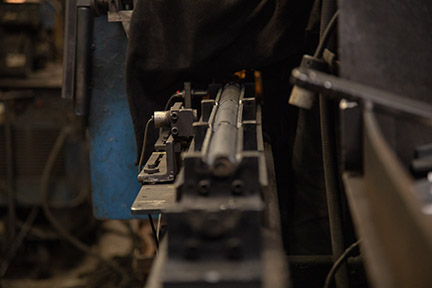
its welded steel drag chain manufacturing processes
(the beginning of their fixed welding operation shown here).
The chains are designed for drag conveyors in rugged
and demanding environments.
“The Insight Core software helps us increase our efficiencies by being able to see the productivity of each machine,” Secoy says. “Then we can address individual problems or troubleshoot from there.”
Improve efficiency and quality with metal-cored wire
The switch to FabCOR 86R metal-cored wire allowed Webster Industries to greatly reduce issues with poor weld penetration. The faster deposition rates, reduced spatter and clean welds also helped the company save time and money in rework, wasted scrap materials and post-weld cleanup.
“We’re looking to expand the use of the FabCOR 86R wire to all of our carbon steel welding applications and in the plant,” Kuenzli says. “It’s actually helped us immensely in terms of adding value to our product and passing that along to our customers. We don’t have to worry about all of the day-to-day issues that we always had to deal with on our weld lines.”
The partnership with Hobart and Miller helped Webster Industries make a smooth transition to the new wire and find additional improvements in the operation.
“They go out of their way to give us training, support and any technical expertise that we need,” Secoy says. “It’s made us more successful in helping meet our customer’s needs in a more timely manner with a better-quality product.”



